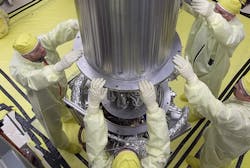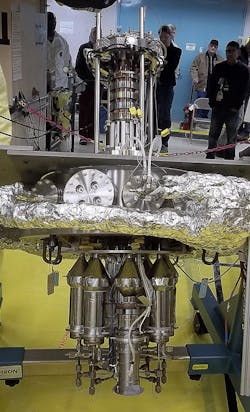Nuclear Power Plant for Space Missions Passes Tests
A small, lightweight fission reactor built at NASA’s Glenn Research Center in Cleveland recently passed extensive testing in the Nevada desert “with flying floors,” putting it one step closer to powering human outposts on the moon or Mars.
“We threw everything we could at this reactor, in terms of nominal and off-normal operating scenarios and KRUSTY passed with flying colors,” says David Poston of Los Alamos National Laboratory, the chief reactor designer.
The recent experiment in Nevada, jointly conducted by NASA and the Department of Energy’s National Nuclear Security Administration (NNSA), demonstrated the plant can generate electricity with fission power and showed it is stable and safe, no matter what environment it encounters. The reactor, dubbed KRUSTY (for Kilopower Reactor Using Stirling Technology, and perhaps a nod towards “The Simpsons”), went through the testing from November 2017 through March.
NASA and National Nuclear Security Administration (NNSA) engineers lower the wall of the vacuum chamber around the KRUSTY system at the Nevada National Security Site (NNSS).
The Kilopower testing was conducted in four phases. The first two phases, conducted without power, confirmed that each component of the system behaved as expected. During the third phase, the team increased power to heat the core incrementally before moving on to the final phase. The experiment culminated with a 28-hour, full-power test that simulated a mission, including reactor startup, ramp to full power, steady operation, and shutdown. Throughout the experiment, the team simulated power reduction, failed engines, and failed heat pipes, showing that the system could continue to operate and successfully handle multiple failures.
The reactor core is in a solid, cast-uranium-235 core about the size of a roll of paper towels. The prototype power plant uses passive sodium heat pipes instead of cumbersome pipes, pumps, plumbing, and a liquid working fluid used by traditional reactors to carry heat from the reactor. In NASA’s new plant, the heat powers two Sterling exterior combustion engines. They spin and turn, generating 10 kW of electricity. That’s enough to run several households continuously. The reactor should generate this power for at least 10 years. This means it could power a human outpost, which is ideal for the Moon, where generating power from sunlight is difficult due to the 14-day lunar nights. The reactor is also fault tolerant, so any loss of cooling leads to an automatic reduction in fission power with no possibility of uncontrolled reactions.
The KRUSTY nuclear powerplant is turned upside down during core assembly at the Nevada National Security Site (NNSS).
“Kilopower lets us carry out much higher-power missions and explore the shadowed craters of the Moon,” said Gibson. “When we start sending astronauts for long stays on the Moon and to other planets, that’s going to require a new class of power that we’ve never needed before.”
The prototype power system uses a solid, cast uranium-235 reactor core, about the size of a paper towel roll. Passive sodium heat pipes transfer reactor heat to high-efficiency Stirling engines, which convert the heat to electricity.
The Kilopower project is developing mission concepts and performing additional risk reduction activities to prepare for a possible future flight demonstration. The project will remain a part of the STMD’s Game Changing Development program with the goal of transitioning to the Technology Demonstration Mission program in Fiscal Year 2020. Such a demonstration could pave the way for future Kilopower systems that power human outposts on the Moon and Mars, including missions that rely on the ability to make propellants and other materials out of local resources.



